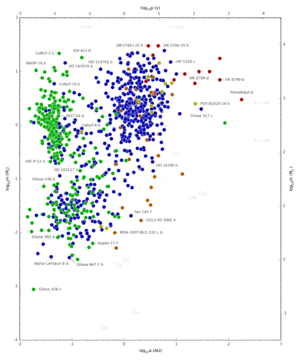Observational astronomy/Extrasolar planet
< Observational astronomyThis learning project will study extrasolar planets. It is very difficult to directly detect planets orbiting distant stars. There are, however, a number of indirect methods. The first activity here will focus on the radial velocity method. Later, another activity will be created that uses the transit method.
Activity
In this activity you will use a computer program called the Systemic Console to examine radial velocity data for stars known to have one or more planets. The goal is to figure out the planetary configuration that best fits the observational data and look for additional planets. The Systemic website contains detailed instructions on how to participate. Here is an overview of the steps involved:

- First, read the introductory pages at Armchair Planet Hunting and What is Systemic?
- Then, follow the instructions to install the Downloadable Console.
- After the software is installed, start the program and go through the steps described in the three part tutorial:
- At this point you should pick a few different stars and try to find the planetary system that is the best fit to the data. A good fit will have a low ChiSq value in the console.
Uploading your results is an end in itself and will help the Systemic project progress. Here at Wikiversity we will concentrate on trying to find the best fit for a small number of the stars in the database. Later, we will be studying exoplanets that are known to transit. So, we'll begin by looking at a few of these systems. If you are going to continue, please sign your name under Active Participants at the talk page.
- Choose HD189733 from the Real Star pulldown menu in the Systemic Console. Try to find a planetary system that best fits the data. Some other systems to try are:
See also
References
- w:Extrasolar planet
- w:Methods of detecting extrasolar planets
- w:Systemic (amateur extrasolar planet search project)
- The Extrasolar Planets Encyclopaedia
- Catalog of Nearby Exoplanets
- Exoplanet Transit Search Observing Program
- The Transiting Exoplanets HD 209458 and TrES-1
- XO-1 Transit Observations
- Summary Table of parameters for transiting planets
- transitsearch.org
